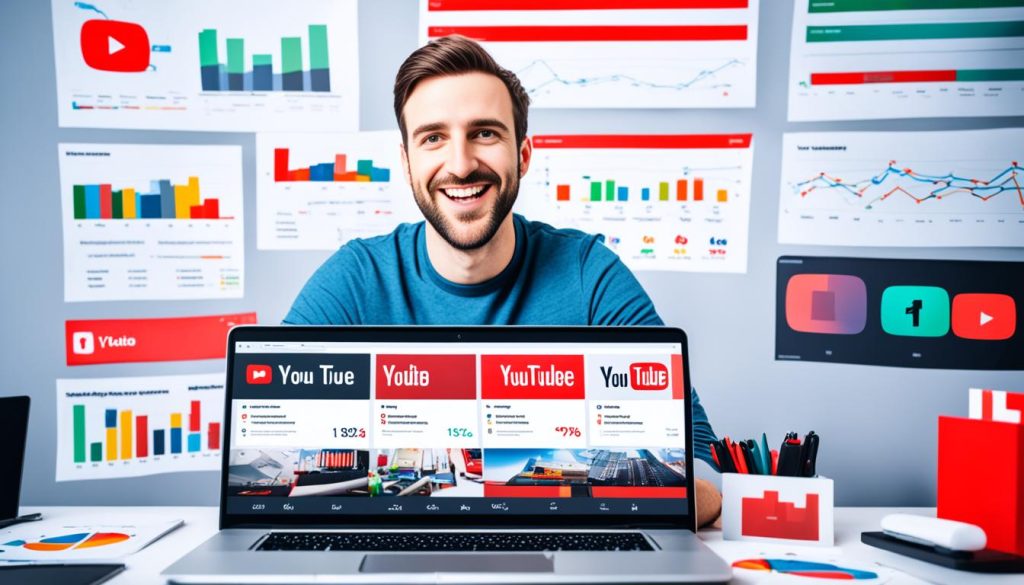If you want to effectively reach your target audience and promote your videos, advertising on YouTube is a must. With billions of users and a wide range of targeting options, YouTube advertising can help you achieve your marketing goals. In this article, we will provide you with valuable tips and strategies on how to advertise on YouTube and make the most out of your campaigns.
How to Advertise on YouTube?
Understanding YouTube Advertising: What’s New and How It Works
YouTube advertising has undergone significant changes in recent years, introducing updates to enhance brand safety and provide advertisers with more targeting options. To effectively advertise on YouTube, it’s crucial to understand how the platform’s ad system works and follow the guidelines for successful campaigns.
Improved Brand Safety
YouTube has implemented stricter policies and enforcement measures to ensure brand safety for advertisers. This includes robust content moderation, ad placement controls, and advanced machine learning algorithms that identify and filter out unsuitable content. These measures help protect your brand’s reputation and ensure your ads are shown in appropriate contexts.
Targeting Options
YouTube offers a range of targeting options to help you reach your desired audience. These include demographic targeting (age, gender, location), interests targeting (based on users’ activities and preferences), and affinity targeting (reaching users who are interested in specific topics). With such precise targeting abilities, you can maximize the impact of your ad campaigns and improve conversion rates.
Ad Formats and Placements
YouTube provides various ad formats to cater to different marketing objectives. The most common ad formats include:
- In-Stream Ads: These video ads play before or during a YouTube video and can be skippable or non-skippable.
- Discovery Ads: These ads appear in search results or on video recommendation pages, encouraging users to click and watch the video.
- Bumper Ads: These short, non-skippable ads appear before the main video and are best for delivering a quick message.
- Masthead Ads: These large, premium placements are displayed on the YouTube homepage and can generate high visibility for brand awareness.
To determine the most effective ad formats and placements for your campaigns, consider your marketing objectives and target audience.
Advertising Guidelines
To ensure your ads comply with YouTube’s guidelines and policies, adhere to the following best practices:
- Create engaging and high-quality content.
- Avoid misleading or deceptive claims.
- Respect copyright and intellectual property rights.
- Avoid excessive repetition or intrusive overlay elements.
- Use appropriate volume levels and avoid overly disruptive audio.
By following these guidelines, you can create ads that resonate with your audience and drive meaningful results.
Summary
Understanding the advancements in YouTube advertising and how it works is crucial for creating effective ad campaigns. Consider brand safety measures, targeting options, ad formats, and follow the advertising guidelines to maximize the impact of your YouTube ad campaigns.
YouTube Ad Pricing: How Much Does it Cost?
When it comes to advertising on YouTube, understanding the cost is crucial in planning your marketing budget. The cost of advertising on YouTube can vary depending on several factors, including your target audience, campaign objective, and the type of ad you choose.
Let’s delve into the details of YouTube ad pricing and explore how you can determine your budget for effective YouTube advertising.
Factors Affecting YouTube Ad Costs
YouTube ad costs are influenced by various factors that determine the reach and effectiveness of your campaigns. Here are key factors to consider:
- Target Audience: The size and demographics of your target audience play a significant role in ad pricing. Generally, reaching a larger audience may require a higher investment.
- Campaign Objective: Different campaign objectives, such as increasing brand awareness or driving conversions, have varying costs associated with them. A campaign focused on generating leads or sales may have a higher cost compared to one aimed at increasing video views.
- Ad Type: YouTube offers various ad formats, each with its own pricing structure. Some ads are charged based on cost per view (CPV), where you pay when someone watches your ad for a specific duration. Others are charged based on cost per click (CPC), where you pay when viewers click on your ad.
By understanding these factors, you can assess the potential cost implications and align them with your advertising goals.
Determining Your YouTube Ad Budget
Before starting your YouTube advertising campaign, it’s crucial to determine your budget to ensure maximum returns. Here’s how you can go about it:
- Define Your Advertising Goals: Clearly identify what you want to achieve through YouTube ads. Are you focusing on increasing sales, driving website traffic, or building brand awareness? Defining your goals will help you allocate your budget effectively.
- Research Average Ad Costs: Conduct research or consult with YouTube advertising experts to get an idea of the typical costs associated with your campaign objectives and target audience size.
- Calculate an Estimated Cost: Based on the average ad costs and your desired campaign duration, estimate the total cost to ensure it aligns with your advertising budget.
Remember, it’s essential to regularly monitor and optimize your ad campaigns to maximize the return on your investment.

Setting Up a Video Campaign on YouTube
Once you’re ready to advertise on YouTube, setting up a video campaign is the first step to reaching your target audience. In this section, we will guide you through the process of creating and managing your YouTube ad campaign using YouTube Ads Manager or YouTube Studio.
Step 1: YouTube Ads Login
To start setting up your video campaign, log in to your YouTube account and navigate to the YouTube Ads Manager or YouTube Studio. If you don’t have an account yet, you can easily create one by signing up on the YouTube website.
Step 2: YouTube Ads Manager
If you choose to use YouTube Ads Manager, follow these steps:
- Click on the “Campaigns” tab.
- Click on the “+ New campaign” button.
- Select your campaign goal, such as increasing brand awareness or driving website traffic.
- Choose your campaign type based on your objectives, such as standard display ads or video ads.
- Set your campaign budget and duration.
- Define your target audience by selecting their demographic traits, interests, and behaviors.
- Create your ad group and select your ad formats.
- Upload your video ad and set your bidding strategy.
- Review and launch your campaign.
Step 2: YouTube Studio
If you prefer to use YouTube Studio, follow these steps:
- Access YouTube Studio by clicking on your account icon and selecting “YouTube Studio” from the dropdown menu.
- Click on the “Monetization” tab.
- Enable monetization for your channel.
- Click on the “Videos” tab and select the video you want to promote.
- Click on the “$ Promote” button below the video.
- Set your campaign goals, budget, and bidding strategy.
- Define your target audience by selecting their demographics and interests.
- Choose the ad formats and placements for your video ad.
- Review and launch your campaign.
Once your campaign is live, monitor its performance using YouTube Ads Manager or YouTube Studio. Make adjustments as needed to optimize your ad delivery and reach your advertising goals.
Setting up a video campaign on YouTube is a straightforward process that allows you to showcase your brand to a vast audience. Whether you choose YouTube Ads Manager or YouTube Studio, follow these steps to create an effective and engaging YouTube ad campaign.

Advertising Options on YouTube: Types of Ads
When it comes to advertising on YouTube, you have a range of options to choose from. Understanding the different ad formats and knowing when to use them can significantly impact the success of your YouTube ad campaign. In this section, we will explore the various types of ads available on YouTube and provide insights on their uses and benefits.
In-Stream Ads
In-stream ads are video ads that appear before, during, or after YouTube videos. There are two types of in-stream ads you can utilize:
- Skippable in-stream ads: These ads allow viewers to skip after a few seconds. They are a great option if you want to capture the audience’s attention quickly without interrupting their viewing experience. Skippable in-stream ads work well for brand awareness and driving traffic to your website.
- Non-skippable in-stream ads: As the name suggests, these ads cannot be skipped by viewers. They typically last for 15 seconds and are best suited for short, impactful messages. Non-skippable in-stream ads are effective for promoting limited-time offers or important announcements.
It’s essential to create captivating and engaging in-stream ads to maximize their impact and drive viewers to take action.
Discovery Ads
Discovery ads, formerly known as TrueView Discovery ads, appear in YouTube search results, on the YouTube homepage, and alongside related videos. These ads are displayed as thumbnail images with a headline and description. When users click on a discovery ad, they are taken to the video’s watch page or a landing page of your choice.

Non-Video Ads
Non-video ads on YouTube encompass a variety of ad formats that do not require a video. These include:
- Bumper ads: Bumper ads are non-skippable ads that are up to 6 seconds long. They are a great way to deliver brief and memorable messages to viewers.
- Overlay ads: Overlay ads are semi-transparent ads that appear on the lower part of a video. They can be text-based or display images.
- Sponsored cards: Sponsored cards are displayed within a video, providing viewers with additional information, such as product details or related content.
Non-video ads are effective for capturing viewers’ attention without the need for a full-length video.
Now that you have a better understanding of the different advertising options on YouTube, you can choose the ad formats that align with your marketing goals and target audience. In the next section, we will share valuable tips for running effective YouTube ad campaigns.
Tips for Effective YouTube Advertising
To achieve success with YouTube advertising, it’s crucial to follow best practices and implement effective strategies. Below are some tips on how to optimize your YouTube ad campaigns and get the most out of your advertising efforts.
1. Define Your Target Audience
Before creating your YouTube ad campaign, clearly define your target audience. Consider their demographics, interests, and behaviors to tailor your ads accordingly. This will help you reach the right people and increase the chances of engagement and conversions.
2. Create Engaging and Relevant Content
Make sure your ad content is attention-grabbing, informative, and relevant to your target audience. Use compelling visuals, captivating headlines, and persuasive calls-to-action to encourage viewers to take the desired action, such as clicking on your ad or visiting your website.
3. Optimize Your Video Titles and Descriptions
When uploading your videos to YouTube, optimize the titles and descriptions with relevant keywords. This will improve your video’s visibility in search results and help attract organic traffic. Additionally, use relevant tags and categorize your videos appropriately to increase their discoverability.
4. Utilize YouTube’s Targeting Options
Take advantage of YouTube’s targeting options to reach your desired audience effectively. You can target specific demographics, locations, interests, and even specific YouTube channels or videos. Experiment with different targeting combinations to find the best approach for your ad campaigns.
5. Monitor and Adjust Your Campaigns
Regularly monitor the performance of your YouTube ad campaigns and make necessary adjustments. Analyze key metrics such as click-through rates, view rates, and conversions to gauge the effectiveness of your ads. Use this data to refine your targeting, ad content, and bidding strategies for better results.

These tips will help you optimize your YouTube ad campaigns and maximize your advertising efforts. By understanding your target audience, creating engaging content, optimizing your videos, utilizing targeting options, and monitoring your campaigns, you can achieve better results and drive the desired outcomes for your business.
Free Advertising on YouTube: Is it Possible?
While YouTube advertising usually involves a cost, there are also opportunities for free advertising on the platform. In this section, we will explore ways to promote your YouTube videos organically and potentially reach a wider audience without spending money.
One of the most effective ways to advertise your YouTube video for free is by optimizing it for search engines. By incorporating relevant keywords into your video title, description, and tags, you can increase its visibility in search results. Remember to use targeted keywords related to your video content to attract the right audience.
Another strategy to advertise on YouTube for free is by actively engaging with your viewers. Encourage them to like, comment, and share your videos, as this can significantly boost your organic reach. Additionally, responding to comments and building a community around your channel can generate more visibility and attract new viewers.
Collaborating with other YouTubers in your niche is another effective way to advertise your video for free. By collaborating on a video or mentioning each other’s channels, you can tap into their audience and gain exposure to a wider range of viewers. Make sure to choose collaborators whose audience aligns well with your target demographic to maximize the impact of the collaboration.
If you have a blog or website, consider embedding your YouTube videos into relevant blog posts or web pages. This can help drive organic traffic to your videos and increase their visibility. Additionally, sharing your videos on social media platforms, such as Facebook, Twitter, and Instagram, can also help promote your content organically to a wider audience.
Conclusion
YouTube advertising is a valuable tool for businesses in the United Kingdom to reach their target audience and promote their products or services. By understanding the various ad options, pricing models, and best practices, you can create successful YouTube ad campaigns that drive results for your business.
When advertising on YouTube, it is important to optimize your videos for search to ensure they appear in relevant searches. Engaging with your audience through comments, likes, and shares can also help to build a loyal following and increase visibility for your channel.
Consider incorporating influencer marketing into your YouTube advertising strategy. Collaborating with popular influencers can help to expand your reach and tap into their established audience base. Additionally, explore paid advertising options to further enhance your YouTube marketing efforts and maximize your campaign’s effectiveness.
FAQs
How much does it cost to advertise on YouTube?
The cost of advertising on YouTube depends on factors such as your target audience, campaign objective, and ad type. YouTube offers different pricing models, including cost-per-view (CPV) and cost-per-impression (CPM).
What are some tips for effective YouTube advertising?
To run successful YouTube ad campaigns, consider optimizing your videos for search by using relevant keywords, engaging with your audience through compelling content, and leveraging influencer marketing and paid advertising options to enhance your strategy.
Can I advertise on YouTube for free?
While YouTube advertising typically involves a cost, there are also opportunities for free advertising on the platform. You can promote your YouTube videos organically by optimizing your video descriptions, titles, and tags, and by sharing your videos on social media and other online platforms.

